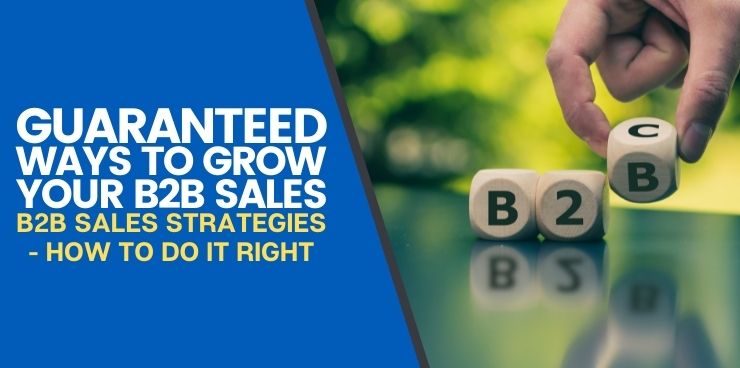We don’t live in the same times that we used to. B2B sales aren’t the same as they used to be, either.
A huge part of business success is that you have to evolve with the times.
Buyers don’t trust experts like they once did. They prefer to trust themselves and conduct solo research before they buy.
Buying processes change to reflect that. If you’re in B2B sales, you also have to consider social media as a motivating factor.
It’s hard to deny that the Internet is a great tool. You have easier access to almost everything you need. But that doesn’t change the fact that it’s harder now to provide what other people need.
Customers use the Internet to gain more knowledge and feel out the competition. So you need to beat the competition.
We have eight strategies for you to use to succeed in better quality B2B sales.
What is B2B Sales?
We have to start at the beginning. So what is B2B sales? It stands for “business to business” sales. This means that B2B companies sell their products and services to businesses.
The opposite of B2B sales is B2C sales, or “business to customer” sales. They sell their products and services to customers directly.
While B2B is a more intricate process than B2C, it also generates longer sales cycles and a bigger average order value.
Today more than ever, you need to be dynamic with your sales strategies when you sell B2B. Let’s go back in time and see how today’s processes are different from those of the past.
Old vs New B2B Buying Process
Here, we show you what happened in the past with each category. Then, we tell you how it happens now.
In general, B2B sales used to be easier.
In the past, here are the steps a client took to buy:
- A client needs a product or service that addresses their needs.
- They call a company that can provide that for them.
- A sales rep answers the phone and tells them what they can purchase and how it directly benefits them.
- If the client wants it, they buy it. It seems easy.
- The marketing department was in charge of lead generation.
- The sales department closed the sale.
Today, the buyer journey is far more extensive and convoluted. Here’s the essence of how it goes today:
- The consumer recognizes that they have a problem.
- They look up how to solve it on the Internet.
- They compile a list of the companies that have solutions.
- They ask around and read reviews of those companies.
- They check social media platforms.
- B2B ads entice them, so they click on them.
- At the end, they might contact a company to buy.
Here’s the key difference: it was easier to predict buyer behavior in the past. Today, there is not a specific order to a consumer’s thought process. Marketing sales is more relevant than sales in general.
What do Modern Buyers Today Consider Before Buying a Product?
There’s another crucial difference in the B2B sales buying process: buyers are fundamentally different because they are younger.
SuperOffice cites a Google professional who says that they are even as young as 18 to 35 years old.
These young businesspeople make the primary decisions for the buying process.
Since they’re young, they prefer technology to get the job done. They don’t call up a local company anymore. They research the products and services themselves. They mainly conduct research through three modern channels: social media posts, forums/FAQs, and peer recommendation.
 Social Media Posts
Social Media Posts
The modern buyer uses social media and they use it often. So you have to build relationships with them on these platforms.
Otherwise, you risk losing them altogether. Old tactics like cold calling lead to irritated customers. If you frustrate someone and interrupt their day, odds are they don’t want to do business with you.
Use a tool that they already use daily to appeal to them. Know your buyer persona. Then analyze some data. What social media networks does your ideal buyer use?
Sales reps should also consider new sales tactics. Engage with potential customers through social media posts instead of the old approach.
Forums/FAQs
There are a few places buyers look to when they want answers. Forums or FAQ pages are popular places to find those answers.
Where specifically, though?
LinkedIn and Quora get a lot of this kind of traffic.
It just makes sense.
Here’s an example: you want a new brand of dish soap and you have dry, cracked hands. You type into your search engine: “Does ____ brand of soap irritate skin?”
You will find some consumer reviews, but you will also find FAQs from the company itself that could answer the question for you. It comes directly from the source.
Follow their example when you use FAQ pages for your B2B company site. Also, look at public online forums to see how you can address any issues people talk about on there.
The modern buyer has specific needs and specific questions. You should provide them with specific products for those needs and answers to those questions.
Peer Recommendation
Peer recommendation is one of the most important things a buyer considers before they purchase.
The B2B sales customer knows that they are not alone. They know that other people have the same questions. A lot of those people have answers, too.
When you buy something online, no matter how big or small, do you usually scroll down to the reviews section? Probably. Most people do.
It goes to show just how much we all trust popular opinion. B2B sales is no different. Your sales process should prioritize peer recommendation.
How to Use Effective Strategies to Generate Better Quality Leads
To be effective in B2B sales, you have to evolve and evolve constantly. But that’s easier said than done. How do you make an action plan to evolve and stay relevant in the cutthroat world of business?
We have eight strategies to start with.
Know Your B2B Customers
Customers know that they deserve a personal and individualized experience when they buy. But do you know your customers? You have to in order to succeed.
First of all, customers demand more than they used to. They expect quick responses to their concerns, even while on the go. They also demand better quality products and services for a less expensive price.
They demand that your team can solve all of their issues according to plan.
Secondly, they want to talk to sales reps that are experienced. They expect that even your bottom-tier employees talk the top-tier talk and walk the top-tier walk.
Next, B2B customers don’t mind a virtual experience now. They don’t typically want to drive to your brick-and-mortar shop to get the information they need. An audio or video call more than suffices.
Similarly, B2B companies are often data pros now. They can analyze consumer data to understand their buyers and create sales marketing campaigns around that data. Guesswork is much less of a factor.
There are several ways you can get to know your customers and their businesses. Use their social media sites among other research tools and ask yourself:
- What are their strengths and weaknesses?
- Who do they compete with?
- Are they hiring? What part of the company is hiring?
- Where do they underperform and lose money?
Create Their Case Studies
It’s great to have the answers to the above questions as a starting point. But if you don’t do anything with that information, it’s pointless. You need to actualize that knowledge.
Look at the following questions about your customers:
- Which of your products do they use the most? How do they use them?
- How do they save time, energy, and money?
Include the following information in your case studies:
- Statistics on how your products’ and services’ features turn into benefits. For example, how much time and money does your software system save a business annually? What about weekly?
- Stories from your customers. Nobody wants to see how a product or service could be helpful. They want to know how it actually is.
- Customer quotes. They should be powerful and speak to your positive brand image.
Understand the Buyer’s Journey
This step in B2B sales accounts for all of the steps your buyer takes.
What do they need to know to take those steps? Who else in their company is involved as a decision-maker? You should appeal to all of those in your marketing and sales tactics.
Here’s how to really succeed and grow: don’t skip out on their pain points. A pain point is basically a particular problem or set of problems that your customer runs into during their buyer journey. Address these. Don’t make them feel like they are unseen or unheard.
Collect Product/Services Feedback
Who better to trust for feedback on your products or services than customers themselves?
If you only collect feedback from internal employees, their bias and company loyalty might blind them.
If you fear that your buyers will be biased too, use anonymous tools to collect feedback.
Here are some ways you can gather product and services feedback:
- Offer surveys through your website
- Conduct interviews with existing customers
- Add a link to a feedback form after they buy your product or service
- Attach a link to a survey in your email newsletters
- Use a rewards program for those who give you feedback (incentives are a useful tool)
Work on Content Marketing
The idea of content marketing is simple. It is a marketing method that produces and distributes content that is appropriate for your market. The content should always provide value.
But actually doing it is trickier than it seems.
Since the modern B2B customer can just search for relevant information online, they don’t always want to reach out. So do it for them. You can educate them with valuable content on sites they already go to. Do this with search engine optimization (SEO). There are plenty of SEO specialists that know how to help you.
 Align Your Sales and Marketing Teams
Align Your Sales and Marketing Teams
To align your sales and marketing teams, use the information you collected to understand the buyer’s journey.
Your marketing team tracks down the lead. They do this with successful campaigns. They might use emails or social media. After your marketing team finishes, your sales team fills the rest of the sales pipeline. Sales reps touch base with the buyers to close the sale.
This leaves you with a streamlined process throughout both departments. You save on revenue when you use these types of internal processes.
Study the Competition
It’s scary to think deeply about the competition. But you have to do it. You can’t shine if you don’t know where the gaps in opportunities are.
A SWOT Analysis helps. Examine the strengths, weaknesses, opportunities, and threats of your business and your competition.
It shows you where you can improve. But it also shows you where your competition can. Improve your own weaknesses and pick up the slack with your competition.
The best way to study your rivals is with social media. Check out their Facebook and LinkedIn pages. Stalk their status updates. Keep up with them and then surpass them.
Offer Buying Options for Your Products/Services
If you just offer a single buying option for your products or services, you discourage businesses.
You should offer three to five choices per product or service. Each one should have a different quality and price.
Every business has different budgets and needs. You have to address that to engage your customers.
Conclusion
B2B sales today contrasts sharply with what it was before. Buyers used to trust in a B2B company for the whole buying process.
Today, you have to build relationships with social media and modern tools to achieve that.
We have strategies at Selling Revolution for all of your B2B sales concerns, and our team of experts sticks with you every step of the way. For more information on our services, book a call with us today and we will lead you to the path of success.


 Social Media Posts
Social Media Posts
 Align Your Sales and Marketing Teams
Align Your Sales and Marketing Teams